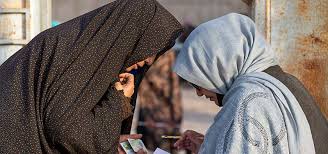- Courses
- GS Full Course 1 Year
- GS Full Course 2 Year
- GS Full Course 3 Year
- GS Full Course Till Selection
- Online Program
- GS Recorded Course
- NCERT (Recorded 500+ Hours)
- Polity Recorded Course
- Geography Recorded Course
- Economy Recorded Course
- AMAC Recorded Course
- Modern India, Post Independence & World History
- Environment Recoded Course
- Governance Recoded Course
- Science & Tech. Recoded Course
- International Relations and Internal Security Recorded Course
- Disaster Management Module Course
- Ethics Recoded Course
- Essay Recoded Course
- Current Affairs Recoded Course
- CSAT
- 5 LAYERED ARJUNA Mentorship
- Public Administration Optional
- ABOUT US
- OUR TOPPERS
- TEST SERIES
- FREE STUDY MATERIAL
- VIDEOS
- CONTACT US
New Survey Shows Half Of Women’s Organizations May Shut Down In Six Months
New Survey Shows Half Of Women’s Organizations May Shut Down In Six Months

Relevance: GS I and II; Social Issues; Social Justice; Women; Globalization; Important Reports;
Why in the News?
A new global report from UN Women reveals a dire warning: half of women-led and women’s rights organisations in humanitarian crisis zones may shut down within six months due to funding cuts.
- This would have devastating consequences for millions of women and families who depend on their services.
|
What are the key findings from the Survey? 1. Scale of the Problem: The survey, conducted in March 2025, included 411 women-led and women’s rights organizations across 44 crisis-affected countries.
2. Risk of Closure: 47% of organizations surveyed said they expect to shut down within six months if funding does not improve. For Example, in Afghanistan, several women’s shelters and legal aid centers have warned they will be forced to close by late 2025, leaving survivors of gender-based violence with nowhere to turn.
3. Widespread Impact: 90% of organizations have already been hit by funding cuts. 51% have had to suspend programs-for example, in Syria, some organizations have stopped running mobile health clinics for women in remote areas. In DRC, legal aid programs for survivors of sexual violence have been paused due to lack of funds.
4. Unmet Needs: Only 7% of the $44.79 billion required for global humanitarian needs was funded in the past year.
|
What are the main reasons behind the ‘Funding Cuts’ for Women’s Organizations?
- Major Reductions in Foreign Aid by Key Donors: The United States, historically the largest global donor, has slashed billions in foreign aid as part of a shift toward "America First" policies. This has been compounded by similar cuts from other major international contributors, such as the UK and European countries.
- Global Economic and Political Priorities Shifting: Donor countries are increasingly prioritizing domestic issues, cost-cutting, and efficiency, often at the expense of international aid. Recent economic pressures, political changes, and efforts to reduce government spending have led to reduced budgets for overseas development assistance and humanitarian aid.
- Escalating and Competing Global Crises: The world is facing multiple, simultaneous crises-such as conflict, climate disasters, food insecurity, and disease outbreaks-which have stretched available humanitarian funding thin. As needs grow, women’s organizations are being asked to do more with less, and their work is often deprioritized in favor of other urgent responses.
- Chronic Underfunding and Lack of Prioritization: Even before the latest wave of cuts, women’s organizations were severely underfunded and often left out of key policy and funding decisions. Gender equality and women’s rights programs have historically received a small fraction of aid budgets, and recent reductions have disproportionately impacted these already scarce resources
|
What specific regions are most affected by the potential closure of these organizations? According to recent surveys and UN] Women reports, the following regions are at greatest risk:
|
How is India getting impacted?
- Reduced Funding and shrinking Budgets: India, like many countries, is experiencing the effects of global aid cuts and declining domestic allocations for women’s welfare. The Union Budget 2025–26 saw a decrease in public spending on social sectors, with the gender budget now only 1.6% of GDP-significantly below the UN-recommended 5%.
-
- The Ministry of Women and Child Development received less than 1% of the total budget, and key schemes addressing gender-based violence and women’s safety (such as Mission Shakti and Samarthya) saw funding slashed by 50%.
- Direct Impact on Women’s Organizations: Many Indian women’s organizations, especially those supporting marginalized groups in crisis-affected regions, are struggling with reduced grants and operational challenges.
-
- Over 60% of such organizations have already reduced their services, disrupting critical support like emergency health care, legal aid, and protection for survivors of gender-based violence.
- Challenges in Health, Education, and Social Services: Funding for education and healthcare has declined, affecting grassroots programs for girls’ education, reproductive health, and nutrition.
-
- Programs like ICDS, PM Poshan, and Anganwadi services require more investment to improve outreach and quality, but face stagnant or reduced budgets.
- The pandemic and economic slowdown have further strained resources, with many grassroots women’s groups reporting layoffs and suspended projects.
- Vulnerable Groups: Poor urban women, women from SC/ST and tribal communities, and the transgender community are particularly at risk as targeted funding and inclusive policies remain inadequate.
-
- Women’s organizations working in conflict-prone or disaster-affected regions (such as Northeast India, Jammu and Kashmir, and flood-affected states) face even greater uncertainty due to both global and domestic funding cuts.
What role can Local Communities play to overcome this crisis? (Way Forward)
- Grassroots Mobilization: Community members, especially women, often take on leadership roles, organize events, and support vulnerable individuals, helping to build stronger, more resilient local networks through groups like Self-Help Groups (SHGs) and Mahila Mandals.
- Program Implementation: Community members like ‘Mahila Housing Trust’ can run and tailor programs for education, health, livelihood, and protection, ensuring these services reach the most marginalized women, including those in rural and urban poor areas.
- Social Support: Communities like ‘Snehalaya’, ‘Sayodhy’ provide emotional support, safe spaces, and solidarity for women facing violence, discrimination, or poverty, and rehabilitate survivors.
- Advocacy and Awareness: Local networks raise awareness about women’s rights, influence local policies, and advocate for change, amplifying the impact of organizations such as MAKAAM and North East Network.
|
PYQ Relevance: Mains: Q. Discuss the positive and negative effects of globalization on women in India? (UPSC CSE 2015) |
|
Also Read |
|
| Public Administration Optional | |
| UPSC Monthly Magazine | Question Answer Practice For UPSC |




